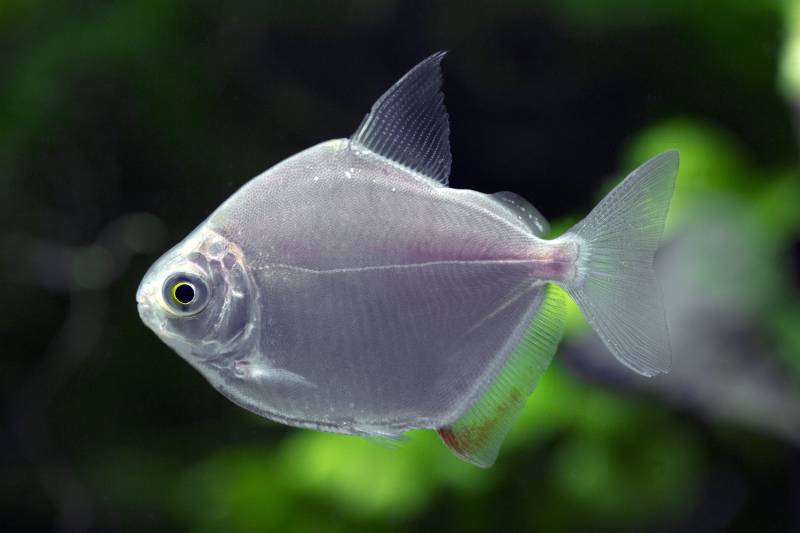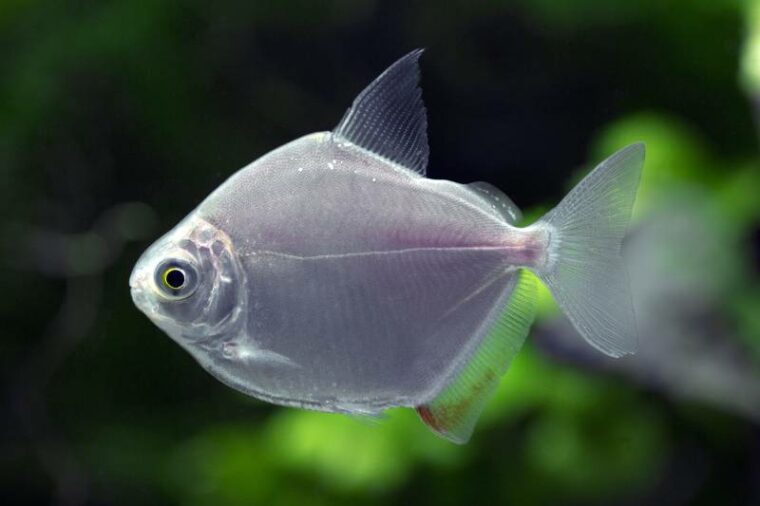- April 5, 2024
Silver Dollar Fish: Care Guide, Pictures, Tank Setup & Info


Adding fish to your aquarium that can immediately become the focal point of the tank is a great way to increase interest and activity in your tank. The Silver Dollar may be just that fish for you. This fish has a unique body shape and a tendency to swim in a way that reflects light from its shimmery body, bringing flashes of light and color to your tank. Read on for more info about the Silver Dollar fish and how to care for one.
Breed Overview
| Size: | Up to 6 inches long |
| Lifespan: | 10 years |
| Similar Breeds: | Tetra species |
| Suitable for: | Fishkeepers of all levels with lots of tank space |
| Temperament: | Peaceful and active (shoaling), shy and timid (alone) |
Have you ever wanted the look of a tiny piranha in your tropical freshwater tank without the risk? The Silver Dollar fish might be perfect for you! A cousin of the piranha, this cute fish is sometimes called the “plant piranha.” They are docile fish, though, so you won’t have to worry about them eating their tank mates or your hand when you put it in the tank.
Silver Dollar Fish Characteristics
Silver Dollar Fish Cost

The Silver Dollar fish is native to South America, usually living in rivers with lots of vegetation, especially tall plants. This is a pretty popular fish in the aquarium trade, though, so you shouldn’t have any difficulty finding them in pet stores, fish stores, and online vendors.
When you purchase a Silver Dollar fish, you can expect to spend between $6 and $15 for a single fish, making them pretty affordable. Keep in mind, though, that these fish are happiest and healthiest when kept in shoals. This means that you should plan to always keep at least six Silver Dollar fish together, with the ideal shoal size being at least 10 fish. Remember this when purchasing your fish, since you will end up paying at least six times more than the base price of the fish to bring home a shoal.
Sociability of the Silver Dollar Fish
Do These Fish Make Good Pets?
Silver Dollars are excellent pets. They are active and eye-catching fish that bring interest and excitement to your tank. If you provide them with an environment that mimics their preferred highly vegetative environment in the wild, then your fish are more likely to be active and fun to watch.

Does This Fish Make a Good Tank Mate?
Yes, the Silver Dollar is a great tank mate to many types of fish. It is a peaceful shoaling fish, so they do well in tropical freshwater tanks with other docile species, like tetras and Plecos. If you don’t keep your Silver Dollars in a shoal, though, then you are likely to have a fish that is jumpy and spends a lot of time hiding. Without the support of a shoal, Silver Dollars become very timid and are likely to hide. They may even become fearful of their tank mates.
Care Guide & Tank Set Up
Water Quality, pH & Temperature
The Silver Dollar is a hardy fish that can tolerate shifts in water quality, but you should aim to always provide excellent water quality to maintain the health of your entire tank. They are tropical fish, so they will need a heated tank that is kept between 75–82°F. They can tolerate slightly acidic water with a pH as low as 6.0. A pH level between 6.0 and 7.5 is acceptable for these fish.

Substrate
Gravel, sand, and aquarium soil all make acceptable substrate choices for the Silver Dollar fish. Gravel is usually considered closest to their substrate in the wild. Whatever substrate you select will need to be able to support plant life, allowing strong root systems to form. You may need to add root tabs to your substrate if you choose an inert substrate like sand or gravel.
Plants
Your Silver Dollar fish will be thrilled if you provide them with a densely planted tank. Tall tropical aquarium plants, like Vallisneria and Anubias, are excellent options. Other good plants to make their environment more natural and comfortable include Java fern, Amazon sword, Java moss, and water lettuce.
Lighting
These fish are likely going to be upset if you provide them with a bright tank light. They prefer dim lighting, but lighting that is filtered through plants is also a great option. Your lighting should be strong enough to support the plant life in your tank.
Filtration
In the wild, Silver Dollars live in rivers, so they will appreciate a little bit of water flow in their tank. They don’t need a strong current, but the water movement from a powerful filtration system, like a hang-on-back or canister filter, will provide them with the movement they prefer.

Things to Know When Owning a Silver Dollar:
Food & Diet Requirements
Silver Dollars are primarily herbivorous fish, and they are known to eat many types of plants. To keep your fish from eating their tank plants, you can provide them with veggies, like spinach, romaine lettuce, zucchini, cucumber, and leafy herbs like basil and cilantro. A community tank food is likely to provide them with proper nutrition, but a varied diet with occasional treats will keep them healthy. They may enjoy small insects or crustaceans, like bloodworms, brine shrimp, and mosquito larvae, but this can vary between fish.

Size & Growth Rate
There are actually multiple species of fish that are referred to as the Silver Dollar, but the most common species in the aquarium trade, Metynnis argenteus, will reach up to 6 inches in length. There have been some reports of them reaching up to 8 inches, but most of them stay below 6 inches when fully grown. These fish are rapid growers, reaching their full adult size by 8 months of age. Make sure to provide them with a large tank, at least 75 gallons for a shoal to ensure they have enough space to thrive.
Lifespan and Health Conditions
With proper care, it’s not unusual for Silver Dollar fish to live to at least 10 years of age, with some reports of fish up to 20 years old in captivity. They are hardy, healthy fish, but they are susceptible to the same issues that most freshwater fish are, including bacterial, fungal, and viral infections and parasitic infestations.
Male vs. Female
It can be tricky to spot the differences between male and female Silver Dollars because they are very similar in appearance. The easiest way to tell the difference is to look at the shape of the anal fin, or the fin located just behind the anal opening. Females have a straight fin that is usually the same color as the rest of the fish. Males have a rounded anal fin that may sport red trim or black bars. Males also sometimes develop black spots behind their gills when breeding season is about to start.
3 Little-Known Facts About Silver Dollars
1. They Can Have Lots of Babies
The average litter size for a Silver Dollar is 2,000 eggs! Unlike many fish, Silver Dollars won’t consume their eggs after laying. The eggs hatch about 3 days after spawning and the fry is unlikely to be eaten by their parents.
2. There Are a Lot of “Silver Dollars”
There are actually 16 different fish species that are referred to as Silver Dollars. While Metynnis argenteus is the most common species in the aquarium trade, Metynnis hypsauchen also makes appearances from time to time. It’s very difficult to tell these two species apart, though!
3. There Is No Concern About Their Numbers
While it’s not uncommon for fish in the aquarium trade to have falling numbers in the wild, the Silver Dollar is not one of those. They are considered to be a species of “least concern.” This means that their numbers are steady or rising and there are no known major threats to the species at this time.

Final Thoughts
The Silver Dollar fish is one of the most popular fish in the aquarium trade, and thanks to its beauty and hardy nature, it’s suitable for beginners and experienced fishkeepers alike. This fish should be kept in shoals of at least six fish to prevent fear and shyness. When kept in shoals, the Silver Dollar tends to be active, engaged, social, and peaceful, making it an excellent tank mate and pet.
Featured Image Credit: boban_nz, Shutterstock
Tags
What do you think?
Related Articles

New Puppy Checklist: Gear You’ll Need for Your New Dog
Getting a new puppy is really exciting, but before you welcome them home, it’s important to prepare your space for them. Since puppies need a

How Big Do Mini Poodles Get? Vet Reviewed Average Weight & Growth Chart – Dogster
The information is current and up-to-date in accordance with the latest veterinarian research. Learn more » When you buy a Miniature Poodle, you might not

Can Police Dogs Smell Nicotine? Vet Verified Facts & Info – Dogster
The information is current and up-to-date in accordance with the latest veterinarian research. Learn more » While cigarette sales have been declining steadily for decades,

How Old Is 5 in Dog Years? Vet-Approved Guide to Each Size of Dog – Dogster
The information is current and up-to-date in accordance with the latest veterinarian research. Learn more » A common method for calculating a dog’s age is



